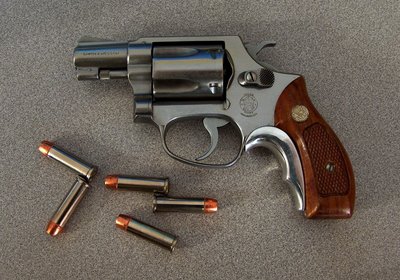Advantages
Disadvantages
Conclusion
More articles
Revolvers have disadvantages, of course; there's no such thing as a free lunch. In the interests of an honest evaluation, here are what I see as revolvers' largest drawbacks. Intellectual honesty demands disclosure of the fact that I consider the following shortcomings fairly minor and the description reflects that attitude. Also, astute observers will notice a distinct disparity between the number of advantages and disadvantages I can identify. (But then you probably shouldn't be reading an article entitled "In Praise of Revolvers" with expectations of clinical objectivity.)
"Firepower"
More commonly known as "ammo capacity", the number of rounds carried in a revolver is one of its more famous drawbacks. A six-shooter sounds downright quaint when semi-autos carrying upward of 15 rounds abound. But if holding a lot of ammunition is an advantage for some semi-autos, it doesn't necessarily follow that revolvers are at a disadvantage. For the elite tactical operators living high-speed low-drag lives, who start hyperventilating and tearing up at the thought of not being able to top off their 15-round 10mm magazines, the prospect of being "limited" to six rounds is apt to make them thrash around on the ground, wrinkling their carefully-pressed multicam as they kick and scream, tears running down their flushed cheeks. I bow to these people's highly-trained and lethal skillset, and would not wish to saddle them with equipment that would compromise their ability to Get The Job Done. Because, as we all know, the type of gun you use and amount of ammo you have on hand are the sole predictors of your survival in a dangerous situation. For the rest of us, though, revolver capacity is a tradeoff that must be weighed against the numerous advantages the platform provides.

Not exactly a pile of ammunition.
Trigger Pull
While revolvers' single-action pulls are for the most part sweet enough to bring tears to a connoisseur's eyes, the double-action mechanism must rotate the cylinder and pull back the hammer against the pressure of the mainspring and rebound slide. Retaining an accurate sight picture throughout this process takes work to perfect. More accurately, a double-action revolver trigger unflinchingly reveals every single flaw in one's trigger technique. This is exacerbated in snubbies, where the short sight radius, small sights, small grips, and the use of a coil mainspring has garnered snub-nosed revolvers a reputation as "belly guns." (This isn't really the case; the mechanical accuracy of snubbies is almost identical to their larger brethren, but they're just harder to shoot well.) My experience has shown that unpracticed shooters do equally well with a double-action revolver as a single-action semi-auto, but once the initial learning curve has passed most people tend to do better with single-action handguns. For those willing to invest the effort, the revolver's double-action trigger is not an insurmountable obstacle, but it does require more practice than lighter mechanisms.
email: hidi.projects at gmail.com